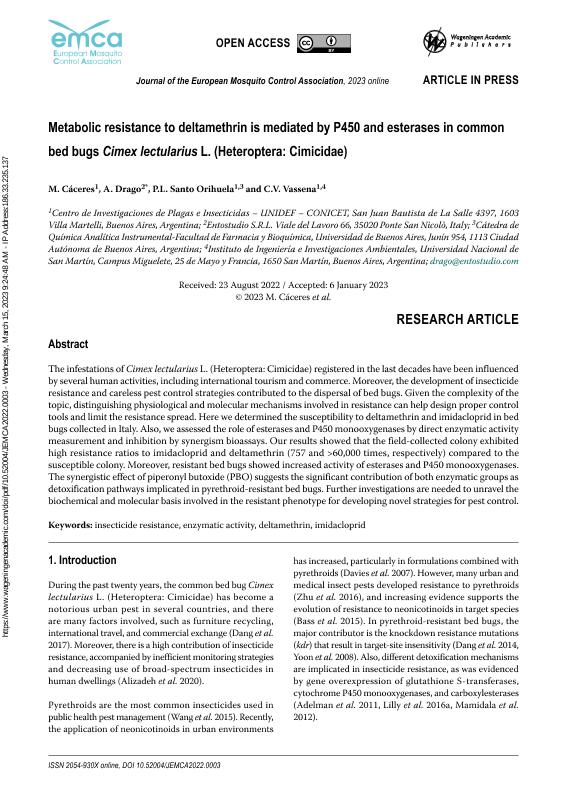Artículo
Metabolic resistance to deltamethrin is mediated by P450 and esterases in common bed bugs Cimex lectularius L. (Heteroptera: Cimicidae)
Fecha de publicación:
02/2023
Editorial:
Wageningen Academic Publishers
Revista:
Journal of the European Mosquito Control Association
ISSN:
2054-930X
Idioma:
Inglés
Tipo de recurso:
Artículo publicado
Clasificación temática:
Resumen
The infestations of Cimex lectularius L. (Heteroptera: Cimicidae) registered in the last decades have been influenced by several human activities, including international tourism and commerce. Moreover, the development of insecticide resistance and careless pest control strategies contributed to the dispersal of bed bugs. Given the complexity of the topic, distinguishing physiological and molecular mechanisms involved in resistance can help design proper control tools and limit the resistance spread. Here we determined the susceptibility to deltamethrin and imidacloprid in bed bugs collected in Italy. Also, we assessed the role of esterases and P450 monooxygenases by direct enzymatic activity measurement and inhibition by synergism bioassays. Our results showed that the field-collected colony exhibited high resistance ratios to imidacloprid and deltamethrin (757 and >60,000 times, respectively) compared to the susceptible colony. Moreover, resistant bed bugs showed increased activity of esterases and P450 monooxygenases. The synergistic effect of piperonyl butoxide (PBO) suggests the significant contribution of both enzymatic groups as detoxification pathways implicated in pyrethroid-resistant bed bugs. Further investigations are needed to unravel the biochemical and molecular basis involved in the resistant phenotype for developing novel strategies for pest control.
Palabras clave:
INSECTICIDE RESISTANCE
,
ENZYMATIC ACTIVITY
,
DELTAMETHRIN
,
IMIDACLOPRID
Archivos asociados
Licencia
Identificadores
Colecciones
Articulos(UNIDEF)
Articulos de UNIDAD DE INVESTIGACION Y DESARROLLO ESTRATEGICOS PARA LA DEFENSA
Articulos de UNIDAD DE INVESTIGACION Y DESARROLLO ESTRATEGICOS PARA LA DEFENSA
Citación
Cáceres, Mariano; Drago, A.; Santo Orihuela, Pablo Luis; Vassena, Claudia Viviana; Metabolic resistance to deltamethrin is mediated by P450 and esterases in common bed bugs Cimex lectularius L. (Heteroptera: Cimicidae); Wageningen Academic Publishers; Journal of the European Mosquito Control Association; 2-2023; 1-6
Compartir
Altmétricas




